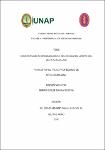| dc.contributor.advisor | Ramal Asayag, Cesar Johnny | |
| dc.contributor.author | Dávila Guerra, Derwin Soler | |
| dc.date.accessioned | 2022-11-22T18:02:22Z | |
| dc.date.available | 2022-11-22T18:02:22Z | |
| dc.date.issued | 2022 | |
| dc.identifier.uri | https://hdl.handle.net/20.500.12737/8556 | |
| dc.description.abstract | The dengue virus represents a constant problem for public health in all the countries that suffer from this disease, so its importance lies in knowing as much as possible about its epidemiological behavior, since this information will be used to implement preventive measures. prevention and control to strengthen health services in our region. The objective of this research was to describe the epidemiological behavior of dengue in Loreto from 2018 to 2021. The research design was descriptive, retrospective, cross-sectional. The study population was 1,423 patients in 2018, in 2019 3,107 patients were involved, in 2020 the patients were a total of 12,895 and in 2021 7,345 patients were registered. The information collection process was through a database provided and authorized by DIRESA-Loreto. The results show that, within the years of study, the largest number of dengue cases were reported in 2020 (52.3%) and 2021 (29.4%), where the most affected population was the female sex with a percentage of 53.38 %, and the most affected age groups were children from 1 to 12 years old (28.0%) and adults from 31 to 59 years old (30.0%). The most affected provinces in the Loreto region were Maynas with 54.8%, Alto Amazonas 30.7%, Loreto 5.7% and finally Ucayali 4.0%. Similarly, the most affected districts in the region were Yurimaguas 27.8%, San Juan Bautista 22.6%, Iquitos 14.4%, Punchana 8.4%, Nauta 4.3% and finally Belén with 4.1%. | en_US |
| dc.description.abstract | El virus del dengue representa una problemática constante para la salud pública de todos los países que sufren de esta enfermedad, de tal manera su importancia radica en conocer lo más que se pueda sobre su comportamiento epidemiológico, ya que esta información servirá para poder implementar medidas de prevención y control para reforzar los servicios sanitarios de nuestra región. La presente investigación tuvo como objetivo describir el comportamiento epidemiológico del dengue en Loreto del 2018 hasta el 2021. El diseño de la investigación fue de tipo descriptivo-retrospectivo de corte transversal. La población estudiada fue de 1,423 pacientes en el 2018, en el 2019 se involucró a 3,107 pacientes, en el 2020 los pacientes fueron un total de 12,895 y en el 2021 se registraron 7,345 pacientes. El proceso de recolección de información fue a través una base de datos proporcionada y autorizada por la DIRESA-Loreto. Los resultados muestran que, dentro de los años de estudio, la mayor cantidad de casos de dengue se reportaron en el año 2020 (52.3%) y 2021 (29.4%), donde la población más afectada fue el sexo femenino con un porcentaje de 53.38%, y los grupos etarios más afectados fueron los niños de 1 a 12 años (28.0%) y adultos de 31 a 59 años (30.0%). Las provincias más afectadas de la región Loreto fueron Maynas con 54.8%, Alto Amazonas 30.7%, Loreto 5.7% y finalmente Ucayali 4.0%. De la misma forma los distritos más afectados de la región fueron Yurimaguas 27.8%, San Juan Bautista 22.6%, Iquitos 14.4%, Punchana 8.4%, Nauta 4.3% y finalmente Belén con 4.1%. | es_PE |
| dc.format | application/pdf | es_PE |
| dc.language.iso | spa | es_PE |
| dc.publisher | Universidad Nacional de la Amazonía Peruana | es_PE |
| dc.rights | info:eu-repo/semantics/openAccess | * |
| dc.rights.uri | https://creativecommons.org/licenses/by/4.0/ | * |
| dc.subject | Epidemiología | es_PE |
| dc.subject | Dengue | es_PE |
| dc.subject | Indicadores demográficos | es_PE |
| dc.title | Comportamiento epidemiológico del dengue en Loreto del 2018 hasta el 2021 | es_PE |
| dc.type | info:eu-repo/semantics/bachelorThesis | es_PE |
| thesis.degree.discipline | Medicina Humana | es_PE |
| thesis.degree.grantor | Universidad Nacional de la Amazonía Peruana. Facultad de Medicina Humana | es_PE |
| thesis.degree.name | Médico Cirujano | es_PE |
| dc.subject.ocde | https://purl.org/pe-repo/ocde/ford#3.03.09 | es_PE |
| renati.author.dni | 71667375 | |
| renati.advisor.orcid | https://orcid.org/0000-0002-3788-8651 | |
| renati.advisor.dni | 29520345 | |
| renati.type | https://purl.org/pe-repo/renati/type#tesis | es_PE |
| renati.discipline | 912016 | es_PE |
| renati.level | https://purl.org/pe-repo/renati/level#tituloProfesional | es_PE |
| renati.juror | Casapia Morales, Wilfredo Martin | |
| renati.juror | Ferreira Yong, Bessy del Pilar | |
| renati.juror | Marín Lizarraga, Johan | |
| dc.publisher.country | PE | es_PE |


